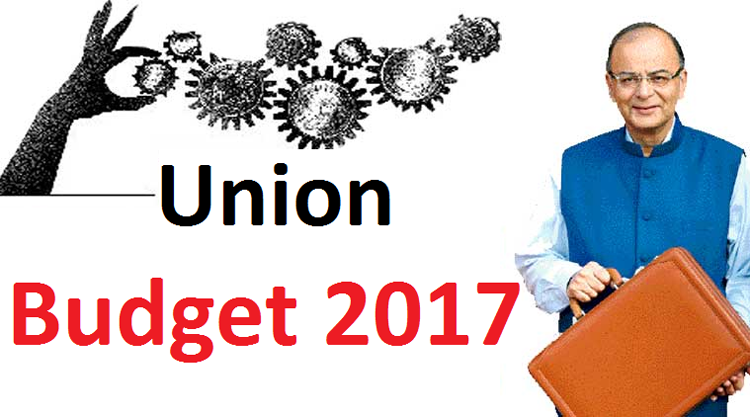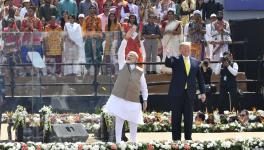Budget in the Press

Union Budget 2017
Newsclick Report
Finance minister, Arun Jaitley’s budget brought out an array of opinion and commentaries on it.
Newsclick presents a compilation of views on the budget from various analysts.
Prakash Karat
The Budget provides no succour to the millions of people who have suffered the consequences of
demonetisation. The large workforce in the informal sector, the migrant labour, the small
shopkeepers and traders, the women who kept tiny savings in cash and the small farmers and
agricultural workers — all of them were hit with the loss of livelihood, wages and savings. There is
economic slowdown which got exacerbated by the demonetisation measure. All indicators show
that there is a fall in output in all sectors and contraction of demand.
But the Budget has refused to acknowledge this reality and does not take any concrete measures to
at least repair the damage done. What was required in such a situation was a substantial increase in
public expenditure. This would have meant not sticking to any rigid fiscal limits. By setting the fiscal
deficit at 3.2 per cent for the next year, this is a contractionary budget. The total size of the Budget
has come down from 13.36 per cent of the GDP last year (Revised Estimates) to 12.74 per cent of
GDP this year. The fiscal deficit target has been achieved through expenditure reduction.
Read more here
Sitaram Yechury
At the outset, this year’s budgetary exercise suffers from a major drawback. Normally, the Budget
relies on the database of the Indian economy which comes in after the third quarter statistics are
tabulated. This usually comes in by the beginning of February for the October-December quarter.
This is an important quarter under normal circumstances as it reflects the impact of the monsoons
and the output of the agricultural sector, the economic backbone for the vast majority of our people.
This year, this quarter is of additional importance for the effect of demonetisation. International
agencies and our own economic survey are projecting a significant fall in our growth rate. By
advancing the Budget to February 1, the database is essentially confined to the first two quarters of
the fiscal year. And, hence, both the calculations and the projections can be seriously flawed.
Read more here
Prabhat Patnaik
The Budget estimates, which have generally become somewhat suspect of late, are particularly
meaningless in the case of the 2017-18 Budget for two obvious reasons: first, the early presentation
of the Budget means the availability of that much less information for the current year, upon which
the Budget is based; and second, the draconian demonetisation that has occurred, while certain to
pull down the GDP growth rate (even the Economic Survey concedes that), makes any precise
prediction impossible. Let us therefore look at the broad strategy of the Budget rather going into its
numbers in any detail.
One obvious thing that stands out here is that while the ratio of the central government’s tax
revenue to the GDP is broadly expected to remain unchanged (the chief economic adviser has said
so explicitly to a group of TV journalists), the ratio of the fiscal deficit to the GDP is to be kept
unchanged (to maintain India’s credit rating in the eyes of global finance). This means that the
central government has decided to keep its expenditure relative to GDP unchanged. Such an act of
“fiscal prudence”, which constitutes the cornerstone of the government’s budgetary strategy, is
staggering in its witlessness. It serves to compound further the folly of demonetisation.
Read more here
Jayati Ghosh
The most striking thing about Arun Jaitley’s Budget presentation for 2017-18 is just how un-striking it
is. A lot was expected from this Budget, and it is largely the government’s own fault that the
expectations were so many and so contradictory. In the event, the finance minister has presented a
very ‘ordinary’ Budget, which is unlikely to satisfy most people who recognise that these are
definitely not ‘ordinary’ economic times.
First, this Budget comes directly in the wake of a demonetisation followed by a painfully slow and
inadequate remonetisation, which has dealt a body blow to the informal sector as well as formal
economic activity. The growth rate is decelerating, and even the finance ministry’s own Economic
Survey recognises that demonetisation’s effects in the current year cannot be fully estimated yet
and may well linger on into the next financial year. If ever there were a case for a more expansionary
fiscal stance to revive demand in the economy, it would be now. But the finance minister has chosen
to stick to his self-declared fiscal deficit target of 3.2% of GDP! Of course, his estimate is based on
huge increases in the revenue projections (more than a Rs 200,000 crore increase in tax revenues,
out of which as much as Rs 88,000 crore is projected to come out of increases in personal income
taxes) which are unlikely to be realised. So it may well be that the actual deficit will be larger if these
higher revenues are not realised. Still, in the current context, with all the global economic headwinds
coming from the new US dispensation and other forces, such fiscal rectitude is surprising to say the
least.
Read more here
Mohan Guruswamy
The presentation of the budget is a much-awaited annual ritual. It was very important in the days of
license raj when the government exercised its discretion or didn’t show it to favor some and punish
others.For instance it was in one such budget that the rates for purified terephthalic acid (PTA) was reduced
and dimethyl terephtalate (DMT) increased to determine the outcome of the most fiercely fought
corporate war in India’s history between two top manufacturers of polyester filament yarn.
Read more here
Thomas Isaac
What should a budget be like in the times of demonetisation? Never like the one presented by
Union Finance Minister Arun Jaitley in the Parliament Wednesday. Instead of providing fiscal
stimulus to the economy, he presented a contradictory budget.
He gave the impression that by the time the Union Budget of 2017-18 would become operational,
demonetisation would be well behind us. But will re-monetisation resurrect the more than 100
people who died either standing in the queue or by committing suicide in their haplessness? Will it
automatically reopen the lakhs of informal sector units that had to be shuttered for want of cash?
Will it be able to restore the shattered investment climate? It is a simplistic view to assume that it
would be business as usual once re-monetisation gets underway. The budget as well as the
Economic Survey has adopted an ostrich-like attitude towards the grave economic crisis the country
faces.
Read more here
Get the latest reports & analysis with people's perspective on Protests, movements & deep analytical videos, discussions of the current affairs in your Telegram app. Subscribe to NewsClick's Telegram channel & get Real-Time updates on stories, as they get published on our website.
























